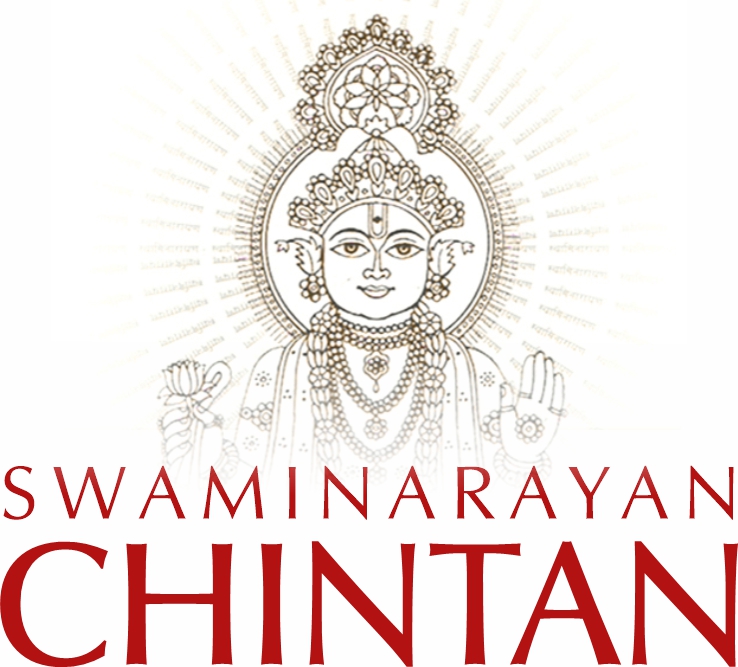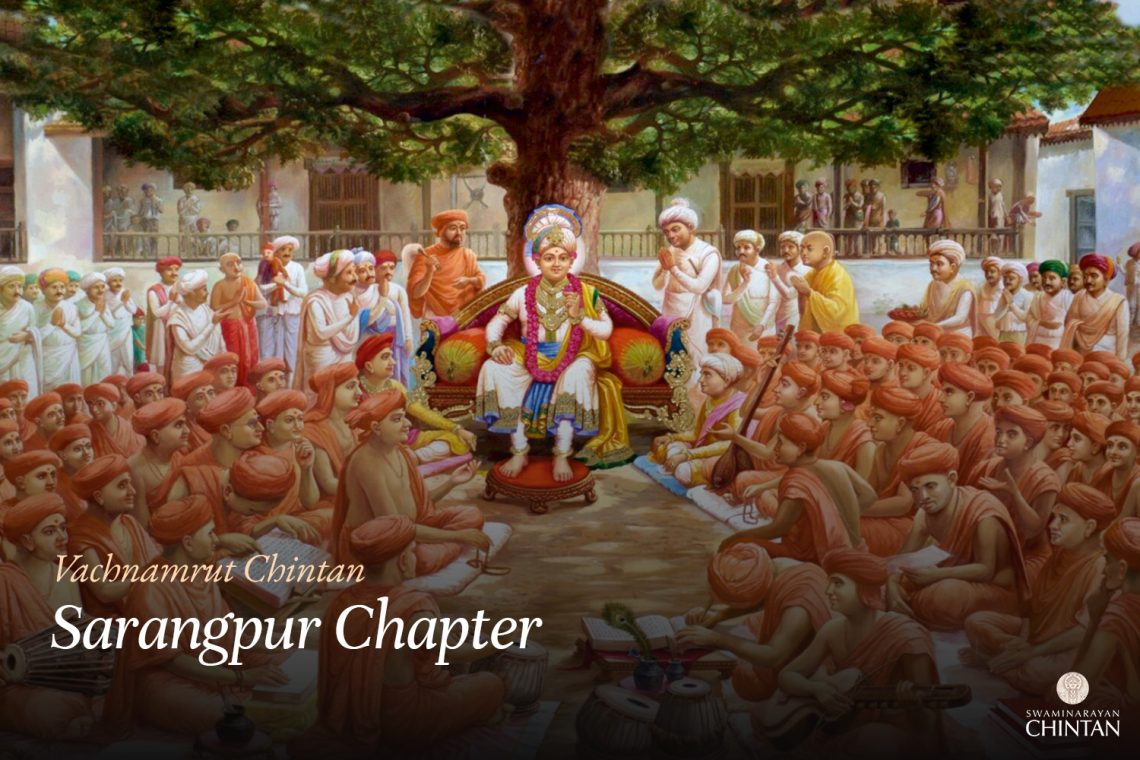Central Insights:
- What is the reason for the prevalence of the Yugadharm in the heart?
Main Points:
- The reason for the prevalence of Yugadharm is the gunas.
- The cause of the activity of the gunas is karma.
- For one who has firm faith in the words of Bhagwan and His Sant, no matter how many tamasik karmas they have, those will be destroyed.
Commentary:
In this Vachanamrut, Muktanand Swami asks a question: “Oh Maharaj! What is the reason for the prevalence of the Yugadharm (properties of different times or eras) in the heart of a person?”
Maharaj replies that the reason is the Gunas (the three attributes of Maya). When pure Sattvagun (attribute of purity) prevails, the heart exhibits the qualities of Satyayug (age of truth and righteousness). When a mixture of Sattvagun and Rajogun (attribute of activity and passion) prevails, the heart exhibits the qualities of Tretayug (age of three sacrifices). When a mixture of Rajogun and Tamogun (attribute of darkness and ignorance) prevails, the heart exhibits the qualities of Dwaparyug (age of duality). When only Tamogun prevails, the heart exhibits the qualities of Kaliyug (age of discord and strife). Thus, the Yugadharm is influenced by the Gunas.
There are two types of yugas. One is the collective yugas of Satya, Treta, Dwapar, and Kali as mentioned in the scriptures, which prevail throughout the earth. The other type is the prevalence of the yugas within an individual’s heart. Various factors contribute to the division of yugas, with time and actions being major factors. Each yuga has its own distinctive activities that are characteristic of that yuga.
In Satyayug, the people primarily engage in knowledge, meditation, and penance. In Tretayug, the focus is on sacrifices, charity, and meritorious deeds. In Dwaparyug, the emphasis is on ritualistic actions, worship, and singing hymns. In Kaliyug, the predominant activities are conflict, deceit, and hypocrisy. These activities define the respective yugas. It is said that the presence of a great divine personality can transform Kaliyug into Satyayug by replacing the negative atmosphere with the positive activities of Satyayug such as penance, meditation, and devotion. This signifies the advent of Satyayug within Kaliyug.
This concept applies to the external environment of society. Maharaj explains that the Yugadharm also prevails in the heart of an individual. Thus, the heart’s inclinations and activities reflect the prevailing yuga. This can be observed through self-reflection. Moreover, the individual’s internal Yugadharm changes over time.
When one feels an inclination towards self-realization, such as an interest in meditation, penance, or following Maharaj’s commands, it indicates the presence of Satyayug in the heart, driven by sattvagun. When one feels an inclination towards charity, meritorious deeds, and altruism, it indicates the presence of Tretayug, driven by rajogun. When the heart harbors a strong desire for fame, wealth, or recognition, and engages in corresponding actions, it indicates the presence of Dwaparyug, driven by both rajogun and tamogun. When the heart is inclined towards conflict, deceit, hypocrisy, or develops an affection for lethargy, inactivity, or anger, it indicates the presence of Kaliyug, driven solely by tamogun.
In short, during the activities of Satyayug, the focus is primarily on Paramatma. In Tretayug, the focus slightly shifts towards virtuous actions and qualities, making God secondary. In Dwaparyug, the focus further shifts to self-interest and ego. In Kaliyug, ego and ill-will towards others become predominant. Higher sentiments lead to spiritual elevation, while lower sentiments lead to downfall.
Muktanand Swami further asks, “Oh Maharaj, what is the reason for the activity of the Gunas?” In other words, if the prevalence of the Yugadharm is due to the Sattvagun, Rajogun, and Tamogun in the heart, what causes these Gunas to change and prevail?
Maharaj replies that the activity of the Gunas is due to past karmas. The Gunas prevail according to one’s past deeds. Therefore, if one with prevailing Rajogun and Tamogun attempts to concentrate on God, they will not succeed. They should rely on the power of Atmanishtha (steadfastness in the self, believing oneself as Jeev distant from body). When feelings of Rajas and Tamas arise, one should recognize them as separate from oneself and maintain the belief that they belong to the Gunas. One should identify oneself as belonging to God and contemplate God’s greatness, acknowledging that even the most sinful person can be redeemed if they seek God’s refuge. Thinking of the redemption of even the great sinner Ajamila, who was saved by merely uttering the name of Narayan at his last moment, one should seek refuge in God, remain joyful, engage in devotion, and serve God and His Sant with faith, adhering to God’s commands. Then, God will show mercy.
Muktanand Swami then asks, “Maharaj, if someone has committed many Tamasik karmas (actions influenced by ignorance and darkness), leading to the prevalence of Kaliyug in their heart, can it be eradicated?” Maharaj replies that if they have immense faith in Bhagwan and His Sant, no matter how Tamasik their karmas are, they will be destroyed, and the Dharma of Satyayug will replace that of Kaliyug. Therefore, if one sincerely engages in Satsang, no fault will remain in their heart, and they will become Brahmrup (in the form of Brahman) even while in their physical body.
Then, Swayamprakashanand Swami asks, “What is meant by Sthan (place)?” Maharaj replies that one’s duties according to their varna and ashram are considered their Sthan. Sthan means role or position. To progress in devotion or the spiritual path, a foundational role is necessary. This foundational role is one’s duty, and from this foundation, one can advance in virtues like detachment, knowledge, and devotion. This sthan varies according to one’s Varna (one of the four castes of Hindu society) and Ashram (one of the four stages of human life). Therefore, Maharaj emphasizes that renunciates should not abandon their duties and behave like householders. Even in times of great difficulty, one should not deviate from their duty. Worshiping God should be done while adhering to one’s duty, as this is the highest form of worship, as commanded by Maharaj.
Glossary
| Yugadharm – Era-specific duties |
| Sattvagun – Mode of goodness The quality associated with purity, knowledge, and harmony, leading to self-realization. |
| Rajogun – Mode of passion The quality associated with activity, desire, and attachment. |
| Tamogun – Mode of ignorance The quality associated with laziness, delusion, and lack of clarity. |
| Satyayug – Age of Truth |
| Tretayug – Age of Sacrifice |
| Dwaparyug – Age of Duality |
| Kaliyug – Age of Discord |
| Karma – Action The deeds performed by a Jeev, which determine its future experiences based on the law of cause and effect. |
| Atmanishtha – Steadfastness in the realization of the soul The firm realization and understanding of the soul’s true nature, living beyond the influence of three kinds of body |
| Brahmrup – Becoming like Brahman |
| Sthan – Role or position |
| Varna – Social classification |
| Ashram – A spiritual community or stage of life Refers to the setting of renunciation or household life, each with its own responsibilities and expectations. |
| Tamasik Karma – Actions of ignorance |
| Spiritual Transformation – Replacing Kaliyug with Satyayug |

